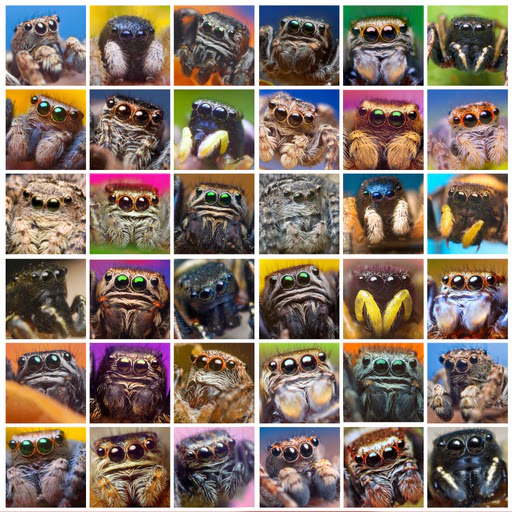The number of eyes on spiders varies from zero to eight. While most spider species have 8 eyes, some spiders like Sinopoda Scurion have no eyes at all!
Arachnophobia, the fear of arachnids—particularly spiders—is one of the most common animal phobias. In fact, research states that almost 3.5% to 6% of the global population fears spiders. However, what makes these multi-legged crawling creatures so scary?
Is it the fact that they appear and disappear almost instantly? They could be there one second and vanish in the blink of an eye. Poof! Or is it just the way the movies depict spiders? Who doesn’t remember Aragog’s sons & daughters trying to make a meal out of Ron and Harry? Or perhaps it’s the number of beady eyes staring back at you? Speaking of eyes… how many eyes are there to worry about?
 Two? Four? Six? Eight? How many eyes do spiders really have? (Photo Credit : Oleg_Serkiz/ Shutterstock)
Two? Four? Six? Eight? How many eyes do spiders really have? (Photo Credit : Oleg_Serkiz/ Shutterstock)
How Many Eyes Do Spiders Have?
The number of eyes on spiders varies depending on their family and species. With such a large number of spider species found on the planet, the number of eyes also varies. The number of eyes and their arrangement on a spider is also used for classification purposes.
While most people assume spiders have two to eight eyes, the actual number depends on the species. Most spiders have 8 eyes, but there are exceptions. For example, spiders in the Caponiidae family have only 2 eyes, and they can grow additional eyes as they mature. Other spider families like Anapidae, Scytodidae, Dysderidae, Sicariidae, Miagrammopes, and Symphytognathidae have 6 or 4 eyes.
 Most spider species have eight eyes, but in different arrangements. Some have a single pair of large primary eyes in the front with three pairs of secondary eyes along the side of the head. Others have very specific and unique arrangements of eyes. (Photo Credit : Paul Looyen/ Shutterstock)
Most spider species have eight eyes, but in different arrangements. Some have a single pair of large primary eyes in the front with three pairs of secondary eyes along the side of the head. Others have very specific and unique arrangements of eyes. (Photo Credit : Paul Looyen/ Shutterstock)
Eyeless Spiders
Interestingly, some spider species have no eyes at all. In 2012, Peter Jäger discovered the first huntsman spider species without eyes. The eyeless huntsman spider was found in a cave in Laos, South Asia. It was named Sinopoda Scurion. Other eyeless spider species like Telemidae, Cicurina, and Kauaʻi cave wolf spider have also been discovered in different parts of the world.
Regardless of whether they have eyes or not, all spiders have their own unique way of perceiving the world. Does having 8 eyes give them an advantage over other animals? How do all 8 eyes work together?
How Do Spider Eyes Function?
Spider eyes can be divided into two categories: Primary Eyes and Secondary Eyes. The primary eyes are the main pair of eyes located at the front, also known as Ocelli, while the smaller outer eyes on the sides of the head are secondary eyes. It is believed that the secondary eyes evolved from the compound eyes of spider ancestors, known as Chelicerata, although they lack the individual facets typically associated with compound eyes.
 Spiders have a total of eight eyes, which allows them to have a wider field of view, with each pair serving a different purpose. (Photo Credit: David Edwin Hill/Wikimedia Commons)
Spiders have a total of eight eyes, which allows them to have a wider field of view, with each pair serving a different purpose. (Photo Credit: David Edwin Hill/Wikimedia Commons)
In other arthropods, primary eyes can only detect the direction of light, but in spiders, primary eyes can also form images. The primary eyes, also called Anteromedial eyes (AME) due to their placement, are used to focus on prey and gather information about the surroundings. They also have muscles that can move the retina to track an image. However, unlike humans and other animals that can move their heads, spiders have fixed primary eyes. Therefore, spiders require additional eyes to support the primary eyes and maximize their field of view.
Secondary eyes are usually smaller and located next to the primary eyes on the sides of the head. Based on their position, they are referred to as anterolateral eyes (ALE), posterolateral eyes (PLE), and posteromedial eyes (PME). The secondary eyes lack the ability to move the retina like the primary eyes, so they remain immobile.
The function of the secondary eyes varies among different species. In most species, they serve as motion analyzers and help spiders detect nearby prey and predators. They also assist in determining distance. Some spider species have a retroreflector tissue layer called tapetum lucidum in their secondary eyes, which aids vision in low-light conditions.
Conclusion
It may seem logical to assume that more eyes would result in better vision overall. However, this is not always the case. 99% of spiders with 4 pairs of eyes still have poor eyesight. Most spiders rely on their sense of smell and taste to hunt for food. They also have touch sensors in the form of hair-like or bristle-like structures called setae, which help them explore their environment. Setae also play a role in their ability to climb vertical surfaces and hang upside down. However, certain hunting spiders such as jumping spiders, wolf spiders, and flower spiders have exceptional eyesight.
